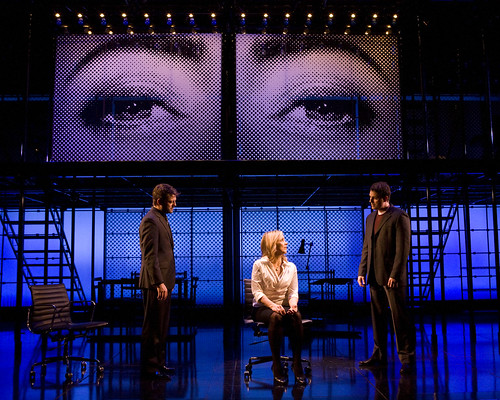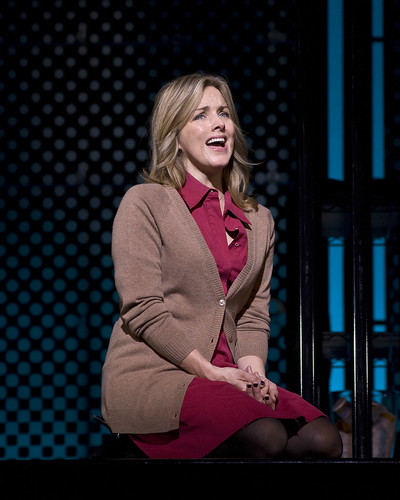Ripley, believe it or not, still rocks Normal
 Jeremey Kushnier (left), Alice Ripley (center) and Asa Somers star in the national tour of Next to Normal at San Francisco's Curran Theatre. Below: Tony Award-winner Ripley sings her plaintive aria, "I Miss the Mountains."Photos by Craig SchwartzWhen I saw Next to Normal on Broadway, I was of two minds. For much of the first act, I glowered in my seat, overwhelmed by the Tom Kitt/Brian Yorkey score – too many lyrics, loud music of the pop-rock-showtune mega-mix variety and super-slick storytelling and direction by Michael Greif.But somewhere in Act 2, I got completely caught up in the story of Diana, a bipolar woman whose illness has dominated and in some ways warped her husband, Dan, and their 16-year-old daughter, Natalie. From the song “Maybe (Next to Normal),” a duet for mother and daughter, to the end of the show, I was in tears.It was the story more than the staging that got to me, and it wasn’t so much the music but the characters and the choices they make that was ultimately so moving.So I left with the question: why does this show have to be a musical? The Pulitzer committee didn’t seem to mind when they handed out awards.Now having seen the show a second time courtesy of the national tour at the Curran Theatre, part of the SHN/Best of Broadway season, I’m wondering less about the music and more about the way the story is over-told.Mark Wendland’s three-level set is essentially a construction site. It’s a metal framework full of rock concert lights (designed by Kevin Adams) and sliding panels that give the impression of a “normal” suburban household. We learn that Diana and Dan were both architecture students, which may also explain the construction site.The three levels, shallow though they may be, certainly allows Greif to move his cast around in dynamic ways. Curt Hansen, who plays the enigmatic and somewhat menacing Gabe, leaps from level to level like a gymnast going for the gold. The tiers can also be read as levels of mental stability. The ground floor is the most grounded in reality. The middle level is dangerous purgatory where you can go either way. And the tippy top is “abandon sanity all ye who enter here.”
Jeremey Kushnier (left), Alice Ripley (center) and Asa Somers star in the national tour of Next to Normal at San Francisco's Curran Theatre. Below: Tony Award-winner Ripley sings her plaintive aria, "I Miss the Mountains."Photos by Craig SchwartzWhen I saw Next to Normal on Broadway, I was of two minds. For much of the first act, I glowered in my seat, overwhelmed by the Tom Kitt/Brian Yorkey score – too many lyrics, loud music of the pop-rock-showtune mega-mix variety and super-slick storytelling and direction by Michael Greif.But somewhere in Act 2, I got completely caught up in the story of Diana, a bipolar woman whose illness has dominated and in some ways warped her husband, Dan, and their 16-year-old daughter, Natalie. From the song “Maybe (Next to Normal),” a duet for mother and daughter, to the end of the show, I was in tears.It was the story more than the staging that got to me, and it wasn’t so much the music but the characters and the choices they make that was ultimately so moving.So I left with the question: why does this show have to be a musical? The Pulitzer committee didn’t seem to mind when they handed out awards.Now having seen the show a second time courtesy of the national tour at the Curran Theatre, part of the SHN/Best of Broadway season, I’m wondering less about the music and more about the way the story is over-told.Mark Wendland’s three-level set is essentially a construction site. It’s a metal framework full of rock concert lights (designed by Kevin Adams) and sliding panels that give the impression of a “normal” suburban household. We learn that Diana and Dan were both architecture students, which may also explain the construction site.The three levels, shallow though they may be, certainly allows Greif to move his cast around in dynamic ways. Curt Hansen, who plays the enigmatic and somewhat menacing Gabe, leaps from level to level like a gymnast going for the gold. The tiers can also be read as levels of mental stability. The ground floor is the most grounded in reality. The middle level is dangerous purgatory where you can go either way. And the tippy top is “abandon sanity all ye who enter here.” This is an intimate story told with only six actors (one of whom plays several parts). The band (under the direction of Bryan Perri) is larger by two players. Though there’s musical staging by Sergio Trujillo, it’s not a dance show. There’s razzle-dazzle, but there doesn’t really need to be.The creative team seemed to fear that this small-scale story could be static, so they amped it up to glitzy Broadway levels, and the result is machine like and distancing.That’s why Alice Ripley’s central performance as Diana is so extraordinary. She won a Tony for the role because she’s the aching human center of this machine. On tour, her performance is still brave in its vulnerability, though she is relying on vocal tricks to manipulate a somewhat ragged voice. She has several vocal ticks that warp certain vowel sounds, but her acting is impeccable. She’s funny and raw and (aside from her too-cute clothes and haircut) utterly believable as a woman losing control of herself.I actually liked Asa Somers as Dan more than J. Robert Spencer on Broadway. Dan is a tricky role to pull off because he’s the “boring” one. He’s the rock on which the rest of the family leans. But he has his own issues, as we see in the revealing reprise of “I Am the One” toward the end of the show, a duet with the limber and strong-voiced Hansen.Emma Hunton as Natalie reveals a gorgeous voice, and though her character’s descent from nose-to-the-grindstone good girl to pill-popping clubber is only sketched in at best, she makes a strong impression. There’s nice chemistry between Hunton and Preston Sadleir as nerdy stoner Henry, a stalwart teen whose heart she has, somewhat inexplicably, captured.In the role of Diana’s doctors – a psychopharmacologist and psychiatrist who eventually prescribes ECT (electroconvulsive therapy) – Jeremy Kushnier gets to be a rock star and a member of the (perhaps evil) medical establishment. It’s nice to see Kushnier back on stage at the Curran, where he played Tommy DeVito in Jersey Boys.With such a sturdy cast executing the material, I come back to my dilemma: why do I fight this musical so strenuously before getting sucked into it? I appreciate that Yorkey and Kitt have created such a serious musical and are aiming for depth and emotion. But as much as I enjoy some of the songs in context – “I’m Alive,” “Superboy and the Invisible Girl” – the score never captured my imagination as much as it blasted my brain. Like a jolt of electricity.FOR MORE INFORMATIONNext to Normal continues through Feb. 20 at the Curran Theatre, 445 Geary St., San Francisco. Tickets are $33-$99. Call or visit www.shnsf.com
This is an intimate story told with only six actors (one of whom plays several parts). The band (under the direction of Bryan Perri) is larger by two players. Though there’s musical staging by Sergio Trujillo, it’s not a dance show. There’s razzle-dazzle, but there doesn’t really need to be.The creative team seemed to fear that this small-scale story could be static, so they amped it up to glitzy Broadway levels, and the result is machine like and distancing.That’s why Alice Ripley’s central performance as Diana is so extraordinary. She won a Tony for the role because she’s the aching human center of this machine. On tour, her performance is still brave in its vulnerability, though she is relying on vocal tricks to manipulate a somewhat ragged voice. She has several vocal ticks that warp certain vowel sounds, but her acting is impeccable. She’s funny and raw and (aside from her too-cute clothes and haircut) utterly believable as a woman losing control of herself.I actually liked Asa Somers as Dan more than J. Robert Spencer on Broadway. Dan is a tricky role to pull off because he’s the “boring” one. He’s the rock on which the rest of the family leans. But he has his own issues, as we see in the revealing reprise of “I Am the One” toward the end of the show, a duet with the limber and strong-voiced Hansen.Emma Hunton as Natalie reveals a gorgeous voice, and though her character’s descent from nose-to-the-grindstone good girl to pill-popping clubber is only sketched in at best, she makes a strong impression. There’s nice chemistry between Hunton and Preston Sadleir as nerdy stoner Henry, a stalwart teen whose heart she has, somewhat inexplicably, captured.In the role of Diana’s doctors – a psychopharmacologist and psychiatrist who eventually prescribes ECT (electroconvulsive therapy) – Jeremy Kushnier gets to be a rock star and a member of the (perhaps evil) medical establishment. It’s nice to see Kushnier back on stage at the Curran, where he played Tommy DeVito in Jersey Boys.With such a sturdy cast executing the material, I come back to my dilemma: why do I fight this musical so strenuously before getting sucked into it? I appreciate that Yorkey and Kitt have created such a serious musical and are aiming for depth and emotion. But as much as I enjoy some of the songs in context – “I’m Alive,” “Superboy and the Invisible Girl” – the score never captured my imagination as much as it blasted my brain. Like a jolt of electricity.FOR MORE INFORMATIONNext to Normal continues through Feb. 20 at the Curran Theatre, 445 Geary St., San Francisco. Tickets are $33-$99. Call or visit www.shnsf.com